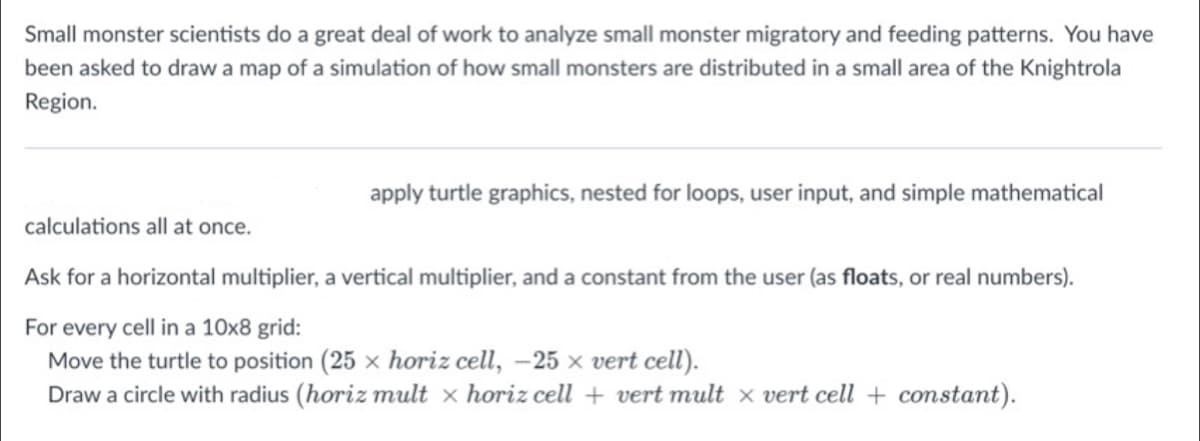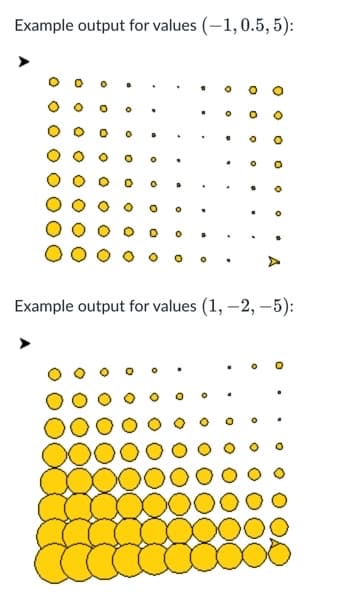Small monster scientists do a great deal of work to analyze small monster migratory and feeding patterns. You have been asked to draw a map of a simulation of how small monsters are distributed in a small area of the Knightrola Region. apply turtle graphics, nested for loops, user input, and simple mathematical calculations all at once. Ask for a horizontal multiplier, a vertical multiplier, and a constant from the user (as floats, or real numbers). For every cell in a 10x8 grid: Move the turtle to position (25 x horiz cell, -25 x vert cell). Draw a circle with radius (horiz mult x horiz cell + vert mult x vert cell + constant).
Small monster scientists do a great deal of work to analyze small monster migratory and feeding patterns. You have been asked to draw a map of a simulation of how small monsters are distributed in a small area of the Knightrola Region. apply turtle graphics, nested for loops, user input, and simple mathematical calculations all at once. Ask for a horizontal multiplier, a vertical multiplier, and a constant from the user (as floats, or real numbers). For every cell in a 10x8 grid: Move the turtle to position (25 x horiz cell, -25 x vert cell). Draw a circle with radius (horiz mult x horiz cell + vert mult x vert cell + constant).
Computer Networking: A Top-Down Approach (7th Edition)
7th Edition
ISBN:9780133594140
Author:James Kurose, Keith Ross
Publisher:James Kurose, Keith Ross
Chapter1: Computer Networks And The Internet
Section: Chapter Questions
Problem R1RQ: What is the difference between a host and an end system? List several different types of end...
Related questions
Question
Python.
Please read the instructions carefully. Make sure the code is correct. I attached example outputs. Thanks!

Transcribed Image Text:Small monster scientists do a great deal of work to analyze small monster migratory and feeding patterns. You have
been asked to draw a map of a simulation of how small monsters are distributed in a small area of the Knightrola
Region.
apply turtle graphics, nested for loops, user input, and simple mathematical
calculations all at once.
Ask for a horizontal multiplier, a vertical multiplier, and a constant from the user (as floats, or real numbers).
For every cell in a 10x8 grid:
Move the turtle to position (25 x horiz cell, –25 × vert cell).
Draw a circle with radius (horiz mult x horiz cell + vert mult x vert cell + constant).

Transcribed Image Text:Example output for values (-1,0.5, 5):
Example output for values (1, –2, –5):
Expert Solution
This question has been solved!
Explore an expertly crafted, step-by-step solution for a thorough understanding of key concepts.
Step by step
Solved in 2 steps with 2 images

Recommended textbooks for you

Computer Networking: A Top-Down Approach (7th Edi…
Computer Engineering
ISBN:
9780133594140
Author:
James Kurose, Keith Ross
Publisher:
PEARSON

Computer Organization and Design MIPS Edition, Fi…
Computer Engineering
ISBN:
9780124077263
Author:
David A. Patterson, John L. Hennessy
Publisher:
Elsevier Science

Network+ Guide to Networks (MindTap Course List)
Computer Engineering
ISBN:
9781337569330
Author:
Jill West, Tamara Dean, Jean Andrews
Publisher:
Cengage Learning

Computer Networking: A Top-Down Approach (7th Edi…
Computer Engineering
ISBN:
9780133594140
Author:
James Kurose, Keith Ross
Publisher:
PEARSON

Computer Organization and Design MIPS Edition, Fi…
Computer Engineering
ISBN:
9780124077263
Author:
David A. Patterson, John L. Hennessy
Publisher:
Elsevier Science

Network+ Guide to Networks (MindTap Course List)
Computer Engineering
ISBN:
9781337569330
Author:
Jill West, Tamara Dean, Jean Andrews
Publisher:
Cengage Learning

Concepts of Database Management
Computer Engineering
ISBN:
9781337093422
Author:
Joy L. Starks, Philip J. Pratt, Mary Z. Last
Publisher:
Cengage Learning

Prelude to Programming
Computer Engineering
ISBN:
9780133750423
Author:
VENIT, Stewart
Publisher:
Pearson Education

Sc Business Data Communications and Networking, T…
Computer Engineering
ISBN:
9781119368830
Author:
FITZGERALD
Publisher:
WILEY